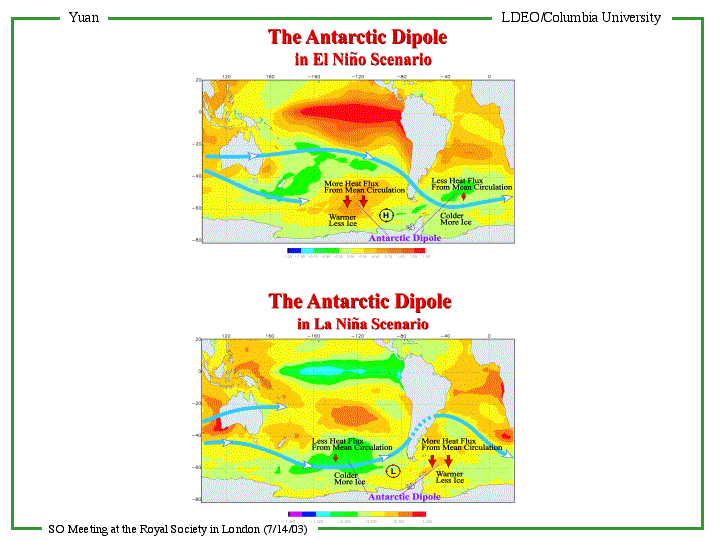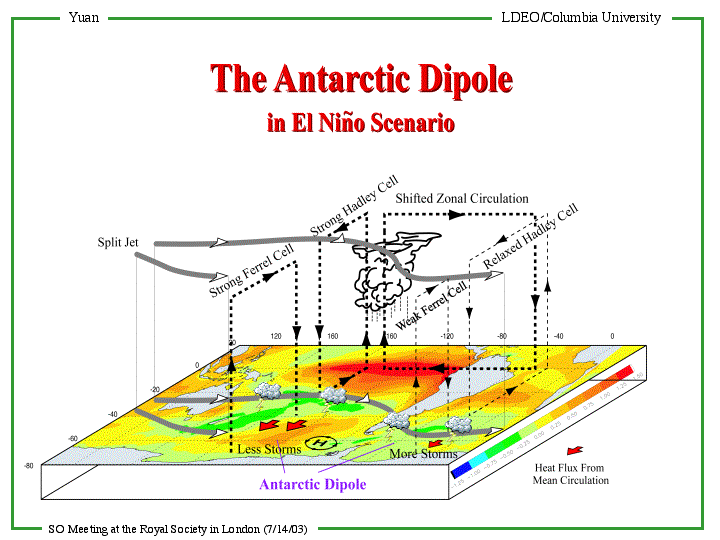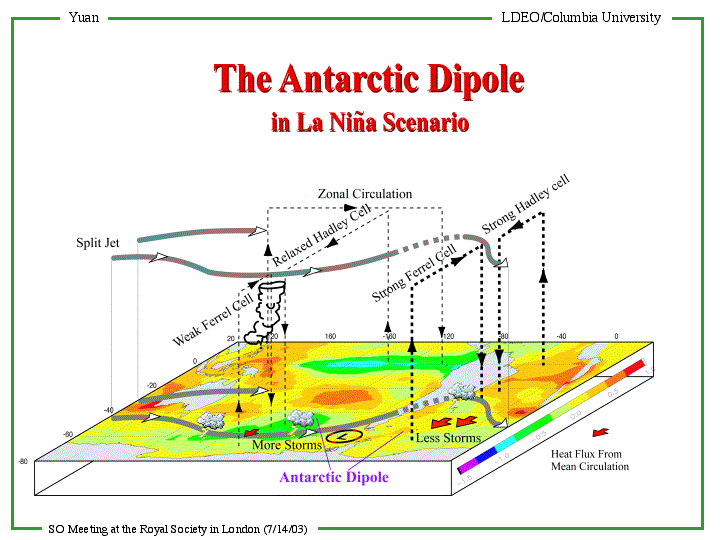
ENSO-Polar Teleconnection
What we have learned from modern observation
My recent study summarizes what we have known about the Antarctic Dipole (ADP) mode in southern high latitudes and associated atmospheric circulation patterns. The Antarctic Dipole is a part of ENSO global anomaly and represents the largest ENSO temperature anomaly outside of the tropical Pacific. For warm events, warm temperature and less sea ice occur in the Pacific center of the dipole while cold temperature and more sea ice occurs in the Atlantic center of the dipole simultaneously. Anomalous temperature and sea ice persist a few seasons in high latitudes after tropical forcing reach its maximum. A persisting high-pressure center exists in the Bellingshausen Sea accompanying the dipole anomaly for warm events. The subtropical jet is enhanced and polar front jet is weakened in the Pacific. In the same time the strong jet stream swings polarward in the Atlantic. In addition, polarward mean heat flux is stronger in the Pacific while weaker in the Atlantic. The La Nina scenario is just a mirror image of the El Nino scenario (Figure 1).

Earlier studies have attributed following mechanisms to the polar-tropical teleconnection: the stationary Rossby Wave associated with the tropical convection (Karoly, 1989), meridional thermal gradient change due to the SST change in the tropics (Rind et al., 2001) and regional meridional circulation change in the atmosphere (Liu et al., 2002). My study summarizes these mechanisms and presents a coherent hypothesis that explains the ENSO teleconnection. In the scenario of El Nino event, the warm SST in the tropical Pacific enhances the tropical convection and meridional thermal gradient from the equator to pole in the Pacific. This strengthens and contracts the Hadley Cell. As a consequence, the subtropical jet is strengthened and storm track is shifted equatorward in the South Pacific. The same tropical warming shifts the zonal circulation eastward creating the descending branch in the tropical Atlantic, which relaxes and expands the Hedley Cell there. Consequently, the storm track shifts polarward there (Rind et al., 2001). In the same time, the Ferrel Cell is strengthened in the Pacific and weakened in the Atlantic in response to the tropical warming. This generates more polarward heat flux in the Pacific and less polarward heat flux in the Atlantic, which directly influence the formation of the Antarctic dipole (Liu et al., 2002). Moreover, the PSA pattern triggered by the same tropical warming has a positive pressure center in the southeast Pacific. The curvature of the jet stream and frequent cyclones in the Atlantic basin (that are usually accompanied by ridges in the upstream) is surmised to create high pressure in the Bellingshausen Sea. These re-enforcements prolong and maintain this center of the PSA, which explains the observed blocking high associated with the warm events. The persisting high-pressure center creates a regional circulation that brings warm air to the polar region in the Pacific and cold air out of the Antarctic continent in the Weddell Sea and directly contributes the formation of the Antarctic Dipole (Figure 2). Therefore, the changes of polarward heat flux due to the changes in the regional Ferrel Cell and regional circulation created by the persisting high-pressure center in the southeast Pacific are the two critical mechanisms for the formation of the Antarctic Dipole. These two processes are both triggered by the ENSO events at the tropics. The changes in the Hadley Cell and Jet Stream links these two high-latitude processes to the tropical forcing. La Nina scenario presents a reversed circulation pattern in the South Pacific and South Atlantic (Figure 3).

Atmospheric circulation patterns and the Antarctic Dipole in El Nino Scenario.

Atmospheric circulation patterns and the Antarctic Dipole in La Nina Scenario.
This page is maintained by Xiaojun Yuan. Last updated: 9/9/03